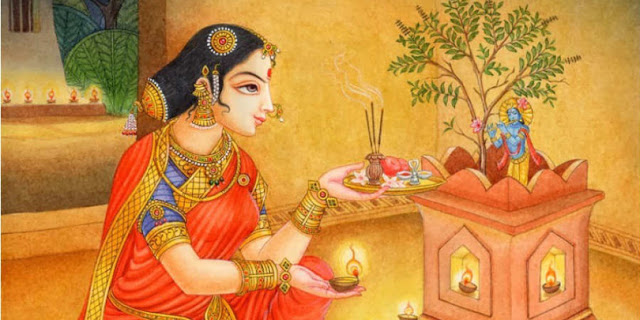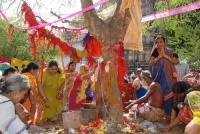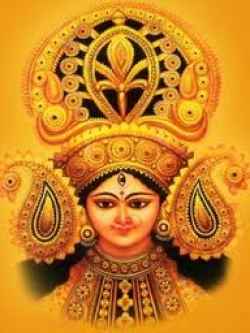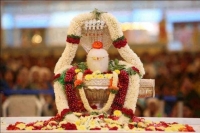
Tulsi Vivaah is the mythical marriage of Sri Krishna, an incarnation of Lord Vishnu with the tulsi plant.
In the Hindu mythology, tulsi is considered to be an incarnation of Goddess Lakshmi, and therefore unison of Gods and Goddesses is observed with great pomp and show all over the country.
Tulsi Vivaah is celebrated on the Dwadashi (12th day) of the Shukla Paksha (bright fortnight) during the month of Kartik, as per the Hindu calendar.
Even though this ceremony can be observed any time between the Prabodhini Ekadashi (11th day) to Kartik Poornima.
In some places it is celebrated for a period of five days, ending on the full moon day of the Kartik month.
Why Does We Celeberate Tulsi Vivah:
As per Hindu mythology, Tulsi was actually a woman named Vrinda who was married to a demon king named Jalandhar.
Vrinda worshiped Lord Vishnu and prayed for her husband to be invincible. No God was able to defeat Jalandhar because of Vrinda. However, Vishnu disguised himself as Jalandhar and violated Vrinda.
Her chastity destroyed, Jalandhar was killed by Shiva. When Vrinda came to know about the truth, she cursed Lord Vishnu and turned him into a black stone (Saaligram) and burnt herself on her husband’s funeral.
Lord Vishnu then transferred her soul in Tulsi plant and as a blessing married her in next birth as Saaligram. Since then the tradition of Tulsi Vivah came in existence.
Who Should do this Tulsi Vivah Puja?
- Unmarried women who are looking for a suitable match
- Women whose marriage is getting delayed for one reason or the other
- Childless couples
Rituals followed during Tulsi Vivaah:
- The marriage ceremony of the Lord Krishna with Tulsi resembles much like any traditional Hindu wedding. The rituals are observed in various temples; however one can easily perform the Tulsi Vivaah at their home.
- The observer of the Tulsi Vivaah must keep the fast till the evening, when the actual ceremonies begins.
- An attractive mandap is made around the tulsi plant suing the sugarcane stalks and is decorated with colourful rangoli. The tulsi plant is then beautifully adorned with bright sari, earrings and other ornaments just like an Indian bride. Vermillion powder and turmeric is also applied on the tulsi plant. A face drawn on a paper is put on the Tulsi plant to which, nose-ring and a bindi is also attached.
- The groom is depicted either as a brass idol or picture of Lord Vishnu. Sometimes even the ‘Shaligram Stone’, symbolic of Lord Vishnu is used for the puja. The image of Lord Krishna/Vishnu is then covered in a dhoti.
- A special vegetarian lunch is prepared for this grandeur occasion. In most of the household’s puris, rice and dal, red pumpkin vegetable and a delicious sweet potato kheer is prepared. The prepared food is then kept aside for ‘bhog’ after the completion of marriage rituals.
- The actual ceremony starts in the evening. As a part of the vivaah ceremony, both Lord Vishnu and Tulsi are given a bath and adorned with flowers, before the wedding. A yellow thread is used to link the couple together for the ceremony.
- The tulsi Vivaah ceremony can either be performed by a priest or women in the house collectively perform the puja. The ritual can be performed by women of all age groups, but only widows are not allowed to participate in the tulsi Vivaah ceremony. The mantras are enchanted all throughout the wedding ceremony. At the completion of the marriage rites, the devotees shower rice mixed with vermillion on the newlyweds.
- After the puja, a tulsi aarti is sung. Once the aarti is finished, the cooked food is offered as ‘bhog’ together with fruits. The prasad is then eaten together with family members and other guests.
- A person who observes the Tulsi Vivaah should also eat a Tulsi leaf that is symbolic of Goddess Tulsi entering the devotee’s body. Prasad in the form of sweets are then distributed among all.
Benefits of Tulsi Vivah:
- Tulsi Vivah is helpful in removing obstacle if delay in marriage
- for well being of the family
- unmarried woman to get a good husband
- childless couples, who perform Tulsi’s kanyadaan, will soon be blessed with kids.
- bring happiness prosperity and wealth
- for family happiness and family comforts
- be blessed with kanyadaan punyam






